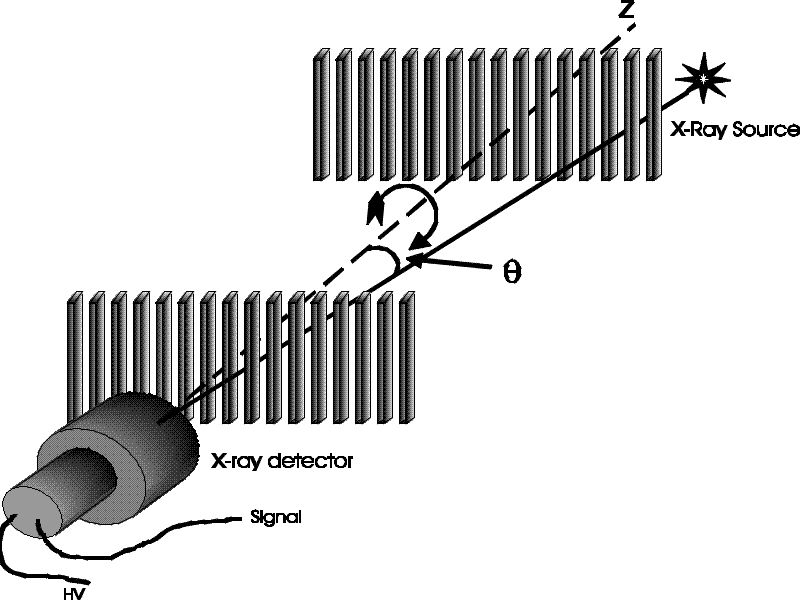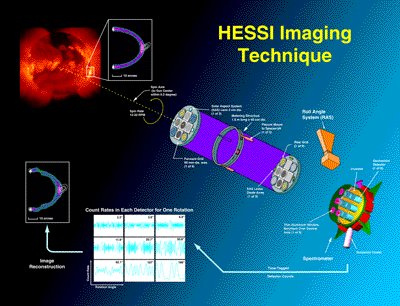|
|
|
Other RHESSI |
|
|
|
|
|
|
|
|
|
|
|
|
How Are Hard X-Ray Images Made?
Since there is great difficulty in focusing hard X-rays by bending them onto a detector, how can scientists form an image? The answer lies in the ability of objects between a light source and a detector to form a shadow. Anyone who has cast shadow figures knows that the position and shape of the hands determines the information or shadow image on the screen. The Sun, however, is not a simple, constant light source. The light output varies in wavelength and intensity from one position to another on the disk. Any X-ray and gamma-ray shadow making device will have to be very dense and quite thick to block high energy photons. The placement position of the blocking elements must be well known in order to identify regions on the Sun that are emitting the radiation.
The Solution:
The HESSI Mission is designed to get above the atmosphere, which tends to block X-rays, and view the Sun through matched sets of grids.

Figure 1. Schematic of one of nine Rotation Modulation Collimators (RMC's) in the HESSI telescope.
Figure 1 was provided by Carl Gaither of Jackson and Tull.
The grid pairs are coaligned so that they modulate the X-rays from a source that is off center from the axis of symmetry (labeled Z). The entire spacecraft is rotated so that the metal bars called slats block the source and then the openings called slits allow the source to shine on the detector. This means that the detector sees a brightening and darkening source in a regular pattern. The rate of change in the brightness is dependent upon the angle from the Z axis and the orientation of the source in the sky with respect to the rotating grid position. To illustrate how the instrument can be used to produce an image of an X-ray point source in the sky, Dr. Ed Schmahl has produced the movies shown in the set of six boxes below. The first five boxes are animated movies that represent one half a rotation of the instrument (2 s in actual time for HESSI) and then repeat continuously. The first five boxes are synchronized in time with each other. The sixth box shows the final image of the source region reconstructed from the data recorded in the half rotation of the movie.
 1.
1.  2.
2.  3.
3.  4.
4.  5.
5.  6.
6.(Click on any of the movies to restart them)
| Box 1 is a probability map of the sky near an assumed point-like X-ray source shown as a circle in the bottom left hand corner. Click on the link for further explanation. |
| Box 2 represents what the detector "sees" as a function of time. |
| Box 3 shows changing X-ray intensity falling on the detector. The changing shades of gray represent the changing numbers of X-ray photons that get through the two grids onto the detector as the spacecraft rotates. The sum of all the photons hitting the detector at a given instant is represented by the brightness of the box image. This variation in transmitted flux is is shown in Box 4 as a function of time during the half rotation of the movie. Note that Boxes 3 and 4 represent the same thing, photon intensity at the detector, in two different manners. |
| Box 4 shows the number of X-ray photons that pass through both grids and reach the detector as a function of time while the instrument rotates. Note the changing period of the variations as the point source in Box 1 appears to move across the bar pattern. First, it appears to move nearly parallel to the probability bars and produces a gradually varying counting rate in the detector. Then, it appears to move nearly perpendicular to the bars and produces a more rapidly varying counting rate. |
| Box 5 represents the continuously reconstructing image formed by the computer. |
| Box 6 is the finished backprojected image. It is placed here so that you can see toward what the Box 4 summation is building. You may hit the stop button at any time and examine the source position in (Box 1) relative to the slats and slits and notice what effect that is having on intensity (Boxes 2 and 3) and image formation (Box 4). Hit reload to start again. |
In summary, X-rays from a source are modulated by the grids (Box 1), hit the detector (Box 2), register as intensity in the computer (Boxes 3 and 4), and finally the computer forms an image (Box 5).
To extract information about the placement in the sky of the source, the computer must know the exact dimensions of the grid and the orientation of the slits at each instant in the rotation. The grid orientation pictured in Figure 1 would give a slow oscillation in brightness since the source would slide along a slit for a while before crossing over a slat. A more horizontal orientation would block the source in a more rapid oscillation since the vertical distance from slit to slat is short. With the placement of the source in the lower left of Box 1, there is a different oscillation pattern from horizontal and vertical slat positions. Watch boxes 1, 2, and 3 to verify the light intensity changes with grid position. So the frequency of oscillation (brightening and darkening) can be linked to a probable position in the sky. The finer the grids and the longer the rotation the more certain the position can be. When 9 grids of different coarseness and different placements about the axis of rotation are operating, the computer can reconstruct a high resolution map of the source. See HESSI Imaging Technique for a graphic summary.
![]()


